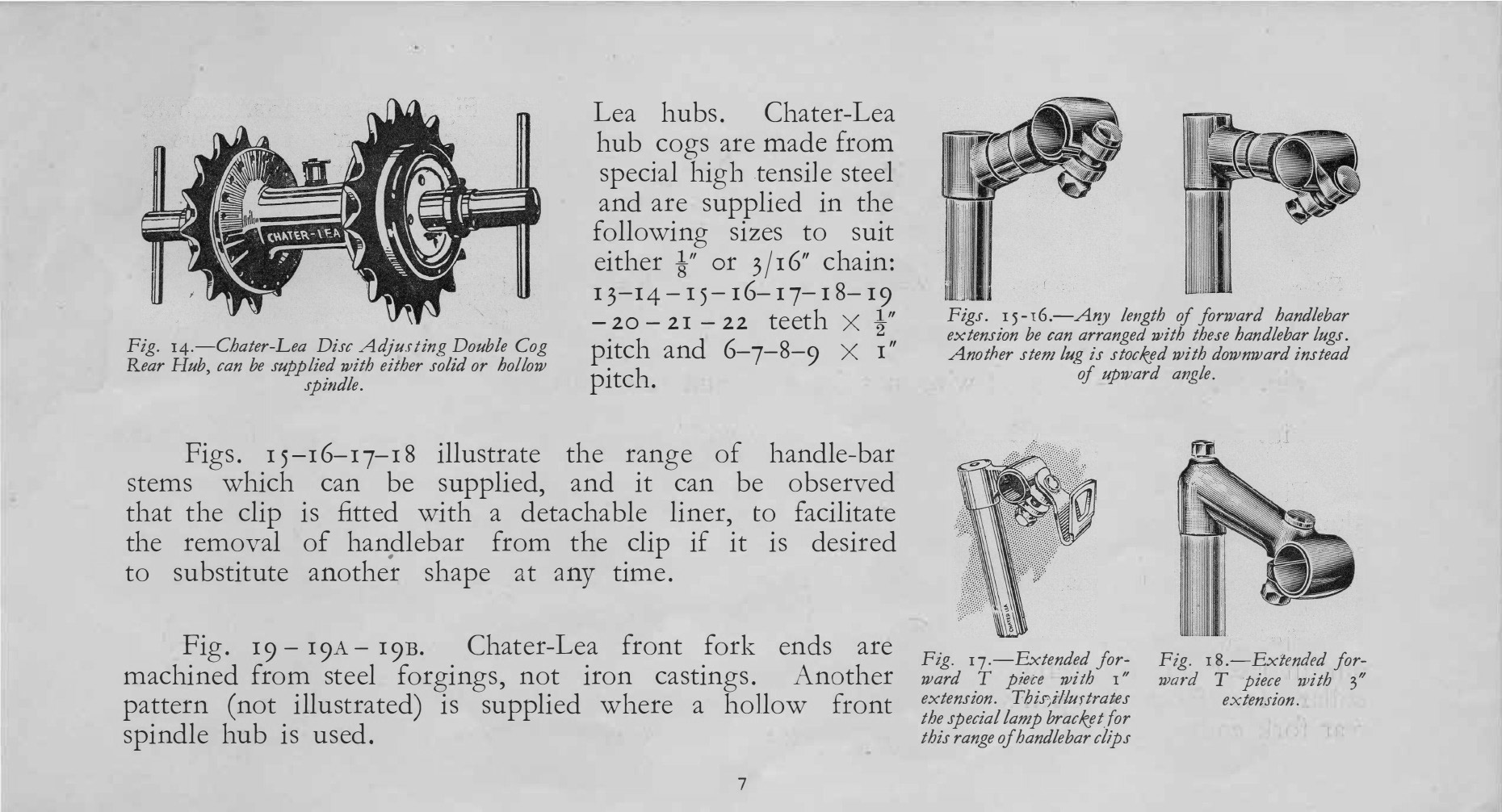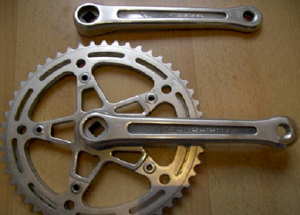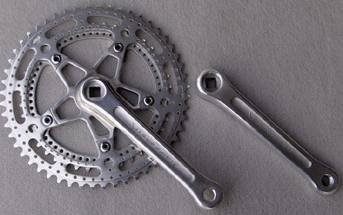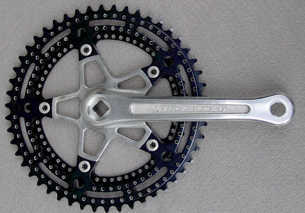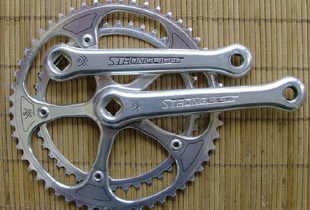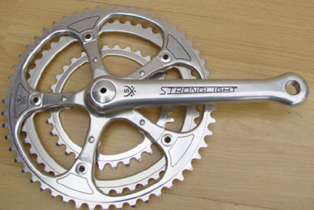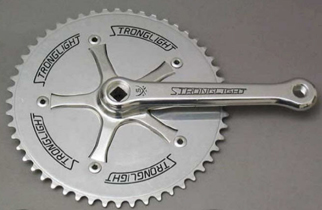Stronglight 5-arm crankset timeline
Posted: Friday 12th June 2020
STRONGLIGHT FORGED ALUMINUM FIVE-ARM CRANKSETS – A BRIEF HISTORICAL SUMMARY:
The original Stronglight 49 debuted prior to WW II and was eventually supplanted by the designated 49D (…that “D” referring to its Duralumin construction as opposed to the 49A where the “A” indicates “Acier” which translates from French as “steel”) that used the same basic crank arms but with altered chain rings (…I believe that this change-over came about sometime approximating 1949, if not just prior). The 49D, or simply 49 as it came to be known once again by the mid 1960’s, was a common sight on a wide variety of bicycles for quite literally decades given that it was produced throughout the 1950’s all the way up until 1984 in only subtly different forms. Along the way, Stronglight also began to offer competition oriented counterparts to its venerable model 49D/49, initially in the form of their models 57 and 63 cranksets (…which were introduced in…you guessed it…1957 and 1963 respectively).

The subsequent Stronglight 93 was introduced in either late 1967 for model year 1968 or during 1968 proper and was produced through 1978, at which point it was superseded by the Stronglight 105 which had debuted two years earlier in 1976. The model 105 bis and 105 ter versions (…the “bis” having factory “drilled” chain rings and the “ter” being not only factory “drilled” but also Black anodized) followed in 1977 and all of these 105 variants remained in production through 1983, at which point they were effectively outplaced by the all new models 106 and 107 cranksets which debuted in 1984 coincident to Stronglight proliferating its line up like never before. To summarize in approximate chronological order of their appearance in the market:
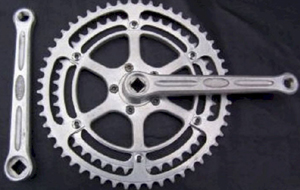
Model 49 – 50.4 mm BCD (outer) / 122 mm BCD (inner) – a traditional five arm crankset from the pre war era where the spyder of the outside chain ring attaches to the drive side arm by virtue of five hex bolts and the inner chain ring attaches to the outer using a total of five chain ring bolts in conjunction with spacers. The natural aluminium finish, non-anodized crank arms themselves have slightly rounded edges with an interrupted center channel having an oval Stronglight logo at the center point of those arms. Intended as an all purpose component with an effective chain ring capacity of 46 to 53 teeth at the outer position and 38 to 48 teeth at the inner position.
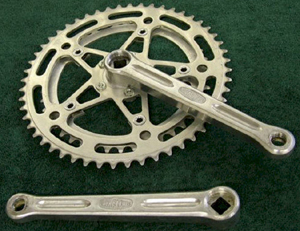
Model 49D (…later simply 49 by the mid 1960’s) – 50.4 mm BCD (outer) / 122 mm BCD (inner on a double or middle on a late model 49 Tn triple) / 86 mm BCD (inner on a late model 49 Tn triple) – the first Stronglight crankset to incorporate the distinctive “star” shaped profile, albeit based upon on the drive side outer chain ring itself, which continued to be attached to the drive side arm using a series of five hex bolts with any inner chain ring attaching to the outer using a total of five chain ring bolts in conjunction with spacers. The natural aluminium finish, non-anodized crank arms themselves have slightly rounded edges with an interrupted center channel having an oval Stronglight logo at the center point of those arms (…available in 165, 170, and 175 mm lengths). Intended primarily for touring use with an effective chain ring capacity of 46 to 53 teeth at the outer position, 38 to 48 teeth at the inner (49 double) or middle (49 Tn triple) position, and 28 to 48 teeth at the innermost (only 49 Tn triple) position.
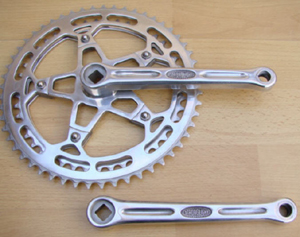
Model 57 SC (…or 57 Super Competition) – 122 mm BCD – incorporating a distinctive “star” shaped spyder, but said spyder was now cast as part of the drive side arm itself, forged as a single unit. The 57 SC uses smaller 8 mm sized chain ring bolts having a hex head unlike Stronglight’s model 63 SC / 93 / 105 successors which all use more conventional 10 mm sized chain ring bolts incorporating a 5 mm Allen keyway in their head. The natural aluminium finish, non-anodized crank arms have decidedly rounded edges with an interrupted center channel having an oval Stronglight logo at the center point of those arms (…available in 165, 170, and 175 mm lengths). Intended for road / racing use with an effective chain ring capacity of 38 to 56 teeth, it is almost exclusively seen configured as a double crankset.
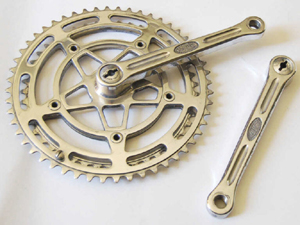
Model 63 (…sometimes referred to as the 63 SC or Super Competition) – 122 mm BCD – an update to the Model 57 SC, it also has a distinctive “star” shaped spyder, again cast as part of the drive side arm itself as a single unit, but now featuring 10mm sized chain ring bolts having a 5 mm Allen keyway. The natural aluminium finish, non-anodized crank arms have only slightly rounded edges with an interrupted center channel having an oval Stronglight logo at the center point of those arms (…available in 165, 170 and 175 mm lengths). Intended primarily for road / racing use with an effective chain ring capacity of 38 to 56 teeth, it is most often found configured as a double but can indeed be built up as a triple crankset.
Model 93 (…sometimes referred to as the 93 SC or Super Competition) – 122 mm BCD – uses a distinctive “star” spyder similar to the 57 SC and 63 SC but having flat faced natural aluminium finish, non-anodized arms with angular edges, an unbroken center channel, and no logo “oval” in the middle of those arms (…available in 165, 170, 172.5,175 and 180 mm lengths). Being a replacement for the 63 SC, the 93 was intended primarily for road / racing use with an effective chain ring capacity of 38 to 56 teeth. It is more often than not seen configured as a double, but can also be built up as a cyclo-cross double with outer aluminum chain ring guard, or a true triple crankset.
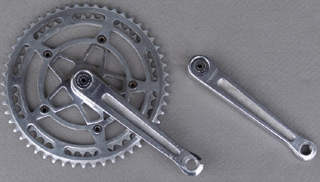
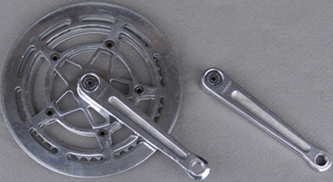
Model 99 / 99 bis – 86 mm BCD – spiritual successor to the 49D (…which continued to be offered concurrently throughout most of the model 99 production lifespan). Its smaller BCD allows for consequently smaller inner chain rings, hence its popularity with the touring crowd. The anodized aluminium crank arms themselves were made available in 165, 170, 172.5 and 175 mm lengths. The model 99 used standard chain rings whereas the 99 bis featured factory “drilled” chain rings. Still, this was an economy model intended primarily for road / touring use with an effective chain ring capacity of 28 to 54 teeth. It can certainly be configured as a double, but more often than not it is seen built up as a triple crankset.
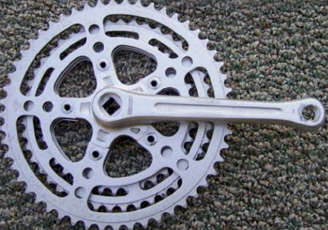
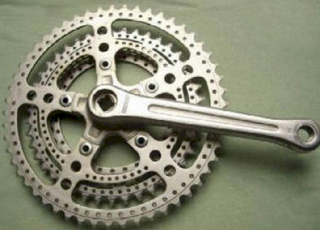
Model 105 / 105 bis / 105 ter – 122 mm BCD – again, uses a distinctive “star” spyder as the 57 SC / 63 SC / 93 before it but returning to slightly rounded edges on its arms which were given an anodized protective finish with a new Stronglight logo appearing inside the milled channel of said arms (…available in 165, 170, 172.5, 175, 177.5 and 180 mm lengths). The 105 used standard chain rings whereas the 105 bis featured factory “drilled” chain rings and the 105 ter had not only factory “drilled” but also Black anodized chain rings. The successor to the model 93, the 105 was intended primarily for road / racing use with an effective chain ring capacity of 38 to 56 teeth. It is more often than not seen configured as a double, but can also be built up as a cyclo-cross double with outer aluminum chain ring guard, or a true triple crankset.
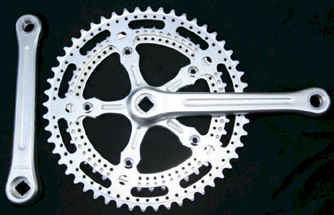
Model 104 / 104 bis – 122 mm BCD – a totally new look for Stronglight and one which was intentionally similar in its appearance to the venerable Campy Record crankset yet still retaining the smaller and traditional 122 mm Stronglight BCD. The anodized aluminium crank arms themselves were made available in only 170 mm lengths. The model 104 used standard chainrings whereas the 104 bis featured factory “drilled” chainrings. Intended primarily for road / racing use with an effective chain ring capacity of 38 to 53 teeth. It can be configured as either a double or triple crankset.
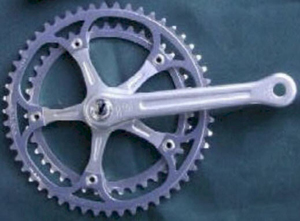
Model 106 – 144 mm BCD – it might well be considered a Campy Record / Super Record clone, this was Stronglight’s top of the line “Pro” kit from the early 1980’s. It featured fluting in the webbing and cutouts in its chain rings and for the first time used the same BCD as Campagnolo (…but at a fraction of the weight). The anodized aluminium crank arms themselves were made available in 165, 170, 172.5, 175, 177.5 and 180 mm lengths. Intended primarily for racing use with an effective chain ring capacity of 42 to 56 teeth (…although you could always affix a Specialites TA or similar 41 tooth 144 mm BCD inner ring), it is almost always seen configured as a double, but can also be built up as a triple crankset.
Model 101 – 122 mm BCD – a mid-range offering based upon Stronglight’s older 122 mm BCD platform but now incorporating aerodynamic lines. The anodized aluminium crank arms themselves were decidedly smooth and rounded with an imprinted logo and were made available in only 170 mm lengths. The model 101 was intended primarily for casual riding applications with an effective chain ring capacity of 38 to 53 teeth. It can be configured as either a double or triple crankset, as well as a double with outboard fiberglass chain ring guard.
Model 103 – 122 mm BCD – a mid-range offering based upon Stronglight’s older 122 mm BCD platform but now incorporating aerodynamic lines. Although visually similar to its model 101 contemporary, the model 103 featured a laterally stepped crank arm profile producing an intentionally wider Q-Factor. The anodized aluminium crank arms themselves were decidedly smooth and rounded with an imprinted logo and were made available in only 170 mm lengths. It was intended primarily for road / racing use with an effective chain ring capacity of 38 to 53 teeth and can be configured as either a double or triple crankset, as well as a double with outboard fiberglass chain ring guard.
Model 107 – 144 mm BCD – something of an “aero” successor to the model 106, again intended for high end racing bikes. The cutouts and fluting are now absent the spyder and crank arms, which were given a protective anodized aluminium finish, and there is a distinctive Stronglight logo running horizontal along the length of the arms (…available in 165, 170, 172.5, 175, 177.5, 180 and 182 mm lengths). Intended primarily for racing use (…there was even a time trial specific version having a single solid plate chain ring) with an effective chain ring capacity of 42 to 56 teeth. It is almost always seen configured as a double, but can also be built up as a triple crankset.
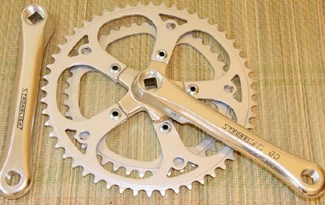
Model 80 – 86 mm BCD – intended as a mid-range successor to the venerable model 99 with which it shares an 86 mm BCD platform. The anodized aluminium crank arms themselves had a decidedly “aero” look to them being smooth and rounded with an imprinted logo, and they were made available in 167.5, 170, and 172.5 mm lengths. Intended for use primarily in road / touring applications, the model 80 had an effective chain ring capacity of 28 to 54 teeth and could easily be configured as either a double or triple crankset.
Model 100 – 86 mm BCD – having a smaller 86 mm BCD in common with the Stronglight models 99 and 80 allowed for consequently smaller inner chain rings apropos the mountain bike crowd. The anodized aluminium crank arms themselves were decidedly smooth and rounded with an imprinted logo and were made available in 167.5, 170 and 172.5 mm lengths. Although visually similar to its model 80 contemporary, the model 100 featured a laterally stepped crank arm profile producing an intentionally wider Q-Factor, similar to the model 103. Intended for use in mountain bike applications, the model 100 had an effective chain ring capacity of 28 to 54 teeth, and it can easily be configured as either a double or triple crankset.
NOTE 01
The 50.4 mm BCD found on the Stronglight 49D/49 was an early de facto standard for cranksets. It is certainly worth noting that this very same BCD can also be found on the contemporary and similarly long running Specialites TA Pro 5 Vis which is commonly known as their Cyclotouriste model. In fact, it is not at all uncommon to find vintage Stronglight 49D/49 crank arms paired with TA chain rings (…less so in vice-versa fashion).
NOTE 02
With respect to any and all of those notations above citing a 38 tooth minimum chain ring size in conjunction with Stronglight cranksets having a 122 mm BCD, that would be the “official” size limitation. Stronglight and perhaps others did, however, eventually manufacture oddball 37 tooth 122 mm BCD rings in extremely limited quantities, but these were never offered as “standard” or “catalog” items (…much in the same way that 41 tooth 144 mm BCD Campagnolo chain rings were never “officially” offered, but nonetheless
do exist).
Posted: Friday 12th June 2020
This article appears in the following categories.
Upcoming Events
Whether you are looking for a gentle social meet up, or a 100-mile ride browse the community’s upcoming events and plan your next weekend outing.
